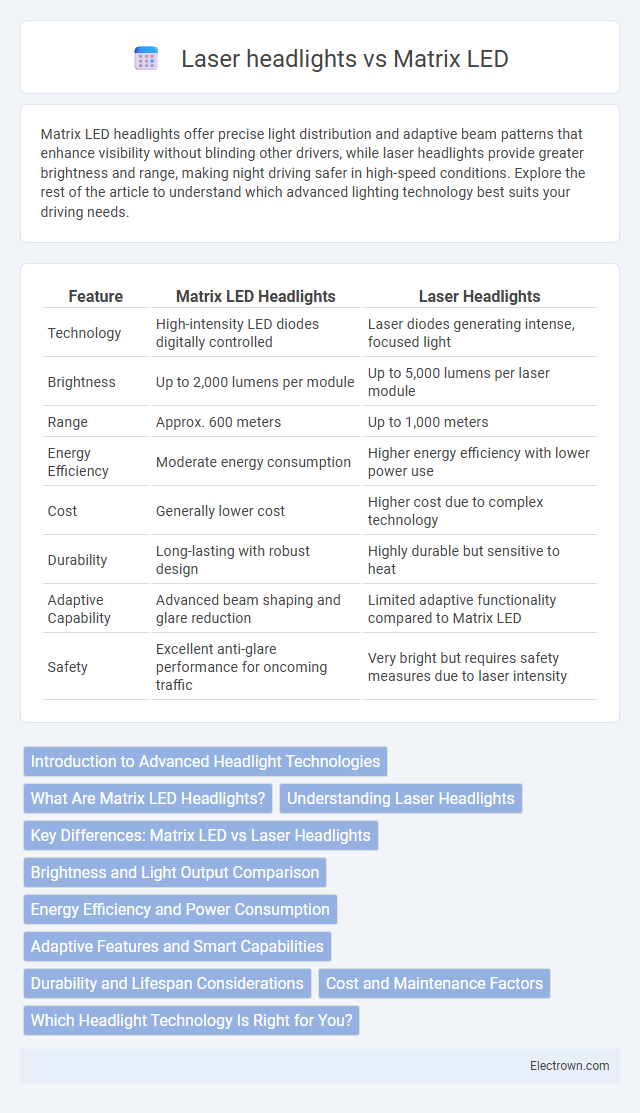Matrix LED headlights offer precise light distribution and adaptive beam patterns that enhance visibility without blinding other drivers, while laser headlights provide greater brightness and range, making night driving safer in high-speed conditions. Explore the rest of the article to understand which advanced lighting technology best suits your driving needs.
Table of Comparison
| Feature | Matrix LED Headlights | Laser Headlights |
|---|---|---|
| Technology | High-intensity LED diodes digitally controlled | Laser diodes generating intense, focused light |
| Brightness | Up to 2,000 lumens per module | Up to 5,000 lumens per laser module |
| Range | Approx. 600 meters | Up to 1,000 meters |
| Energy Efficiency | Moderate energy consumption | Higher energy efficiency with lower power use |
| Cost | Generally lower cost | Higher cost due to complex technology |
| Durability | Long-lasting with robust design | Highly durable but sensitive to heat |
| Adaptive Capability | Advanced beam shaping and glare reduction | Limited adaptive functionality compared to Matrix LED |
| Safety | Excellent anti-glare performance for oncoming traffic | Very bright but requires safety measures due to laser intensity |
Introduction to Advanced Headlight Technologies
Matrix LED headlights utilize an array of individually controllable LEDs to provide adaptive lighting, enhancing visibility while reducing glare for oncoming traffic. Laser headlights offer higher brightness and longer range by using laser diodes to excite phosphor, producing intense and focused beams ideal for high-speed driving conditions. Both technologies represent significant advancements in automotive lighting, improving safety and energy efficiency compared to traditional halogen and xenon systems.
What Are Matrix LED Headlights?
Matrix LED headlights utilize an array of individually controlled LEDs to provide adaptive lighting that enhances road visibility while minimizing glare for other drivers. Your vehicle's lighting system can selectively dim or brighten specific sections of the beam, maintaining optimal illumination in various driving conditions. This technology offers superior precision compared to traditional laser headlights, improving safety and driving comfort.
Understanding Laser Headlights
Laser headlights use laser diodes to produce a highly focused and intense light beam, offering greater brightness and longer range compared to traditional LED or Matrix LED headlights. They operate by exciting a phosphor material, which converts laser light into a powerful, white illumination ideal for high-speed driving and improved nighttime visibility. This advanced technology enables precise beam control, reducing glare for oncoming traffic while enhancing road safety.
Key Differences: Matrix LED vs Laser Headlights
Matrix LED headlights use multiple individually controlled LED segments to create adaptive lighting patterns, improving visibility and reducing glare for oncoming traffic. Laser headlights, on the other hand, emit highly focused beams with greater brightness and range, enabling superior long-distance illumination while consuming less energy. The key differences lie in brightness, range, energy efficiency, and complexity of adaptive lighting technology.
Brightness and Light Output Comparison
Matrix LED headlights deliver superior brightness with adaptive beam patterns, offering enhanced visibility without dazzling oncoming traffic. Laser headlights generate higher light intensity and can illuminate longer distances, often exceeding 600 meters, compared to Matrix LED's typical range of around 300 meters. Both technologies improve road safety, but laser headlights maintain an edge in maximum light output and long-range illumination.
Energy Efficiency and Power Consumption
Matrix LED headlights offer superior energy efficiency by using individual LEDs that adjust brightness and direction precisely, reducing power consumption significantly compared to traditional lighting systems. Laser headlights consume less power than conventional high-beam headlights while delivering a much stronger and more focused beam, enhancing visibility without excessive energy use. Both technologies prioritize minimizing energy waste, but Matrix LEDs typically provide more efficient power management due to their modular design and adaptive lighting capabilities.
Adaptive Features and Smart Capabilities
Matrix LED headlights use individually controlled LEDs to dynamically adjust light patterns, reducing glare for oncoming traffic while maximizing road illumination, enhancing safety in various driving conditions. Laser headlights offer intense brightness and extended range but lack the granular adaptive control of Matrix LED systems. Your choice depends on whether you prioritize advanced smart features and adaptability or maximum brightness and distance.
Durability and Lifespan Considerations
Matrix LED headlights offer long-lasting performance with an average lifespan of around 20,000 hours, making them highly durable and efficient for extended use. Laser headlights, while providing superior brightness and range, typically have a shorter lifespan of approximately 10,000 hours, requiring more frequent replacement. Understanding these durability and lifespan considerations helps you make an informed choice tailored to your vehicle's lighting needs.
Cost and Maintenance Factors
Matrix LED headlights generally have lower initial costs and simpler maintenance compared to laser headlights, due to their widespread adoption and established technology. Laser headlights, while offering superior brightness and range, involve higher upfront expenses and more complex repairs, often requiring specialized servicing. The cost-effectiveness of Matrix LEDs makes them a popular choice for premium vehicles seeking advanced lighting without excessive maintenance overhead.
Which Headlight Technology Is Right for You?
Matrix LED headlights offer precise light distribution by selectively dimming specific segments to avoid dazzling other drivers while enhancing visibility, making them ideal for urban and highway driving with frequent traffic. Laser headlights provide a brighter, longer-range beam capable of illuminating up to 600 meters, perfect for high-speed or rural driving where extended visibility is critical. Choosing between Matrix LED and Laser headlights depends on your typical driving environment, with Matrix LED excelling in adaptive urban settings and Laser headlights suited for maximum illumination on open roads.
Matrix LED vs Laser headlights Infographic

 electrown.com
electrown.com